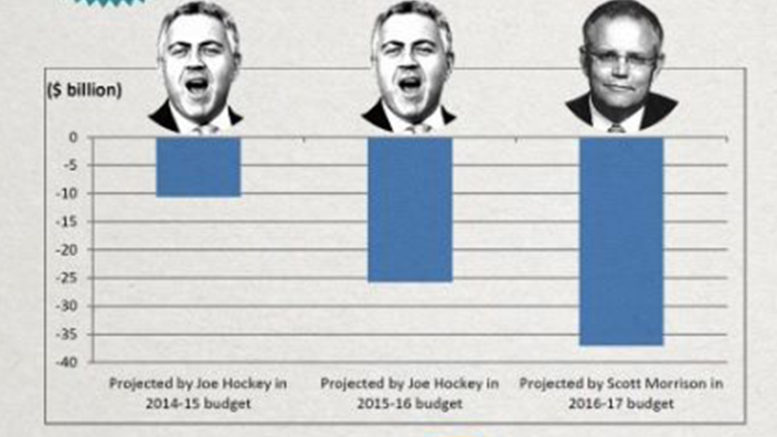Alan Austin’s article published by Independent Australia (26 February 2017), exposes the lie of cost cutting to reduce the budget deficit. The budget deficit argument has been used as an excuse for everything. But rather than cut it down, the Coalition has managed to double it, according to official figures. The article focuses on a comparison between the Rudd/Gillard Labor governments and the Coalition Abbott/Turnbull Coalition governments.
Alan Austin does not directly deal with the argument that Australia really faces a revenue crisis rather than a budget crisis nor that the Coalition does not actually really see the deficit reduction as a priority. It is not the purpose of this article to deal with these other questions. They have been mentioned, only because they help to fill in the context of the debate.
It is now official. The Coalition has just doubled the government debt Labor incurred between 2007 and 2013. But with no devastating global recession to combat. No pressing need for economic stimulus. No extensive infrastructure investment to show for it. And in much shorter time.
If we recall the doomsday denunciations by the Coalition and the media of the debt during the Rudd and Gillard years, this must be the exclamation point on one of the most hypocritical narratives in Australia’s political history.
Labor inherited a net surplus in late 2007. It increased this surplus substantially after the election and reduced significantly the gross debt — which had remained jammed around $60 billion for four years. Then, just as all indicators were looking good, in late 2008, the global economy imploded. This required Australia and every other developed country, except Norway, to borrow extensively.
Over its tenure, Labor incurred $161,253 million in net debt, one of the world’s lowest accumulations relative to gross domestic product (GDP). Labor was in office for five years and nine months.
According to figures released on Friday night by the Finance Department, the Coalition has now more than doubled the net debt to $323,821 million. This has taken three years and five months.
Gross debt – the total borrowings on which interest must be paid – is now $476,945 million, an increase of $206,967 million over the 2013 election level. That is 97.9% of the amount Labor added.
Significantly, Labor’s borrowings grew modestly compared with other developed countries. Australia’s net debt by 2013 was just 12.7% of GDP, according to the International Monetary Fund. New Zealand, Canada, Switzerland and Qatar were then above 27%. Germany and Israel were above 50%. The UK, France and the USA were all above 80%. Japan was above 140%.
The trend over the journey in each regime also contrasts markedly. Under Labor, the borrowing rate reduced steadily towards the end of its tenure. Only $8,020 million was added over its last 12 months, a rate of $668.3 million a month. The Coalition, however, is accelerating its rate of borrowing. Over its last 12 months, net debt has gone up $35,054 million — a rate of $2,921.2 million per month. That’s a higher borrowing rate by a factor of more than four.
The most important contrasting reality, of course, is the global financial crisis from 2008 to 2013, which required borrowed funds for vast stimulus spending. In 2009-10 all developed economies except Australia and Poland were in recession. By 2013, none were. Hence from 2013 onwards, the case for extensive borrowing pretty much ceased to exist. Well-managed economies since 2013 have balanced spending with tax and other revenue.
Developed countries now in budget surplus – and paying down their debt – include Canada, New Zealand, Germany, Luxembourg, Norway, Hong Kong, Singapore, Kuwait and Qatar. Sweden and Switzerland are in balance.
The response from the craven commentariat to these debt outcomes could hardly be more disparate. Throughout the last year of the Gillard/Rudd period, while net debt rose only marginally, the outrage was deafening.
Almost daily, headlines decried ‘Debt spiralling out of control’, or ‘The budget in freefall’, or ‘Labor’s debt timebomb’.
The Daily Telegraph screamed in 2013 that ‘Julia Gillard’s gift to Australia is massive and growing debt’.
The Herald Sun headed a shock horror editorial ‘Labor’s debt bomb’. The 2013 pre-Christmas fiscal outlook, it claimed, gave Australians ‘a shocking insight into the state of the national economy. The news is not good. It’s terrible.’
The fury went on and on, in The Courier-Mail, the Australian Financial Review, the ABC, online outlets and elsewhere.
Then Opposition Leader Tony Abbott was scathing, week in week out:
“Labor has turned a $20 billion surplus into $167 billion in accumulated deficits … That is $6,000 for every Australian man, woman and child.”
He promised many times to “repay Labor’s debt”. Abbott specifically said in 2012 that the Coalition had
“… identified $50 billion of savings, for an $11 billion improvement in the budget bottom line and a reduction of $30 billion in net debt.”
The ABC claimed the economy was the primary issue in the 2013 election campaign and that the
‘… Coalition’s main line of attack on the economy is based on the mantra of “debt and deficit”.’
Now, in contrast, barely a peep from Australia’s spineless and mendacious mass media.
Of course, most countries, including Australia, should carry some government debt. That is quite acceptable. But condemning one administration when debt reaches X billion dollars during the worst recession in 80 years, but ignoring another notching up two times X during the global recovery is simply not acceptable.


Be the first to comment on "Its own figures say the Coalition has doubled the debt"